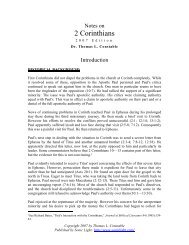1 Samuel - Odessa, Missouri Community of Christ
1 Samuel - Odessa, Missouri Community of Christ
1 Samuel - Odessa, Missouri Community of Christ
You also want an ePaper? Increase the reach of your titles
YUMPU automatically turns print PDFs into web optimized ePapers that Google loves.
2007 Edition Dr. Constable's Notes on 1 <strong>Samuel</strong> 11problem, they approach the problem very differently. Scene 1 [vv. 3-8]treats the problem <strong>of</strong> barrenness as a matter <strong>of</strong> family struggle. In scene 2[vv. 9-18] the same problem has been redefined in Yahwistic categories <strong>of</strong>need, submission, and trust." 23When believers find ourselves in difficult situations, we should commit our desires toGod in prayer. In prayer we should seek what is best for God primarily (cf. Matt. 6:9-10).The purpose <strong>of</strong> prayer is to enable us to accomplish God's will, not to get Him to do ourwill. We should also pray earnestly. When we pray this way, God will enable us to feelpeace in our problem (cf. Phil. 4:6-7).A birth announcement 1:19-20Hannah's godly character surfaces again in the naming <strong>of</strong> <strong>Samuel</strong>. His name probablymeans "heard <strong>of</strong> God" or "God hears." 24 Hannah, whose name means "grace" or"graciousness," recognized that <strong>Samuel</strong>'s birth was not just a coincidence. It was ananswer to prayer and a supernatural gift from God."Yahweh is the key actor in the narrative. Hannah could speak complaintand petition only because she submitted to Yahweh. Eli could giveassurance to her only because he spoke on behalf <strong>of</strong> Yahweh. The son isborn only because Yahweh remembered. Everything depends on askingYahweh and being answered by Yahweh. Thus scene 3 [vv. 19-20]resolves scene 1 [vv. 3-8], but only by way <strong>of</strong> the decisive intrusion <strong>of</strong>Yahweh through scene 2 [vv. 9-18]." 25The parents' thanksgiving 1:21-28a"Scenes 3 [vv. 19-20] and 4 [vv. 21-28a] are a pair, not unlike the pairing<strong>of</strong> 1 [vv. 3-8] and 2 [vv. 9-19]. They are the two scenes <strong>of</strong> resolution. . . .These two scenes are concerned not with the birth, but with Hannahcoming to terms with the reality <strong>of</strong> Yahweh. She is portrayed as the onewho is needy, trustful, submissive, and grateful. She is a model <strong>of</strong>fidelity." 26The Mosaic Law required an <strong>of</strong>fering to God when He granted a vow (Lev. 27:1-8).Elkanah went to the central sanctuary to make this <strong>of</strong>fering shortly after <strong>Samuel</strong>'s birth(v. 21). The text refers to Hannah's vow as Elkanah's (v. 21). It was his vow in this sense:since he did not cancel it when he heard about it, he became responsible for it asHannah's husband (cf. Num. 30:1-8).23 Brueggemann, p. 37.24 Another possibility is "the name <strong>of</strong> God."25 Brueggemann, p. 37.26 Ibid., p. 39.








